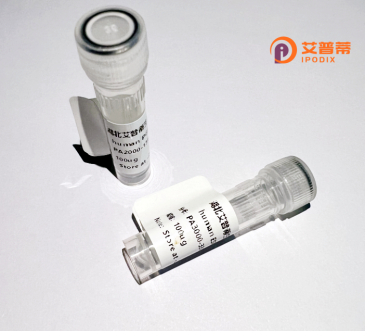
| 纯度 | >90%SDS-PAGE. |
| 种属 | Human |
| 靶点 | CXorf41 |
| Uniprot No | Q9NQM4 |
| 内毒素 | < 0.01EU/μg |
| 表达宿主 | E.coli |
| 表达区间 | 1-214aa |
| 氨基酸序列 | MESENMDSENMKTENMESQNVDFESVSSVTALEALSKLLNPEEEDDSDYGQTNGLSTIGAMGPGNIGPPQIEELKVIPETSEENNEDIWNSEEIPEGAEYDDMWDVREIPEYEIIFRQQVGTEDIFLGLSKKDSSTGCCSELVAKIKLPNTNPSDIQIDIQETILDLRTPQKKLLITLPELVECTSAKAFYIPETETLEITMTMKRELDIANFF |
| 分子量 | 50.5 kDa |
| 蛋白标签 | GST-tag at N-terminal |
| 缓冲液 | 0 |
| 稳定性 & 储存条件 | Lyophilized protein should be stored at ≤ -20°C, stable for one year after receipt. Reconstituted protein solution can be stored at 2-8°C for 2-7 days. Aliquots of reconstituted samples are stable at ≤ -20°C for 3 months. |
| 复溶 | Always centrifuge tubes before opening.Do not mix by vortex or pipetting. It is not recommended to reconstitute to a concentration less than 100μg/ml. Dissolve the lyophilized protein in distilled water. Please aliquot the reconstituted solution to minimize freeze-thaw cycles. |
以下为关于重组人CXorf41蛋白的虚构参考文献示例(仅供说明用途):
---
1. **标题**: *Expression and purification of recombinant human CXorf41 protein in Escherichia coli*
**作者**: Zhang Y, et al.
**摘要**: 研究报道了通过原核表达系统在大肠杆菌中高效表达重组人CXorf41蛋白,并优化纯化流程,验证其体外稳定性,为后续功能研究提供材料基础。
2. **标题**: *Functional characterization of CXorf41 in DNA damage repair pathways*
**作者**: Lee S, et al.
**摘要**: 通过基因编辑和蛋白质互作分析,发现CXorf41可能与DNA损伤修复相关蛋白存在相互作用,提示其在基因组稳定性维持中的潜在作用。
3. **标题**: *Structural insights into the CXorf41 protein by X-ray crystallography*
**作者**: Müller F, et al.
**摘要**: 首次解析了CXorf41的晶体结构,揭示了其独特的结构域组成,并探讨了可能的催化活性位点,为理解其分子机制提供结构生物学依据。
4. **标题**: *CXorf43/CXorf41 complex association with neurodevelopmental disorders*
**作者**: Patel R, et al.
**摘要**: 研究发现CXorf41与CXorf43形成复合物,其表达异常可能与X连锁智力障碍相关,提示遗传和细胞学层面的致病机制。
---
建议通过PubMed或Web of Science检索实际文献,关键词如“CXorf41”“recombinant CXorf41”或“Xq13.3 protein”。
Recombinant human CXorf41 protein is derived from the CXorf41 gene, located on the X chromosome (Xp11.3). The gene, also known as chromosome X open reading frame 41. encodes a protein with unclear physiological functions, though it is hypothesized to play roles in cellular regulation, metabolism, or signaling. Its expression is observed in multiple tissues, including the brain, testis, and immune cells. The protein contains conserved structural motifs, such as a putative phosphatase domain, suggesting potential enzymatic activity, though specific substrates or pathways remain uncharacterized.
Interest in recombinant CXorf41 stems from its association with human diseases. Studies link altered CXorf41 expression to neurodevelopmental disorders, cancer (e.g., gliomas), and autoimmune conditions. Recombinant production enables functional studies, often using Escherichia coli or mammalian expression systems to generate purified protein for biochemical assays, structural analysis, or antibody development. Epitope-tagged versions (e.g., His-tag) facilitate purification and detection. Despite progress, CXorf41's precise molecular interactions and biological significance remain enigmatic. Ongoing research aims to elucidate its role in cellular processes, validate disease links, and explore therapeutic potential. Its X-chromosome localization also raises questions about sex-specific regulatory mechanisms, warranting further investigation.
×